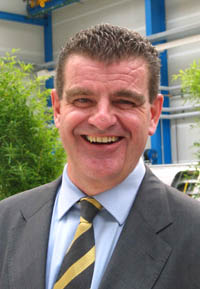
6 November 2009
Stadler Pursues International Ambitions
| | 
Peter Spuhler.
|
Bussnang Switzerland - How has a medium-sized manufacturer like Stadler reached the point where it can compete successfully with the biggest names in the rolling stock business? Anitra Green caught up with CEO and majority shareholder Peter Spuhler to find out.
Twenty years ago, when Peter Spuhler took over Stadler Rail in Bussnang, it was a small company among several other Swiss manufacturers of rolling stock. Today it generates annual revenues of more than CHF1 billion and is the only purely-Swiss company left in the field. Furthermore, in certain key markets it has chalked up an enviable degree of success in the face of competition from the major world players. How was it done?
The answers, according to Spuhler, include emphasis on quality, new concepts, and technology, team spirit, a clear focus on what is feasible, a feeling for the market, and luck. "The most important factor in our success is that we have the best team, especially in the engineering department, which has a lot of experience," he says. "Our big chance for picking up the best engineers came when the traditional companies in Switzerland closed down, our success would not have been possible without these people." The companies which folded included Schindler Waggon, from whom Stadler took most of the Altenrhein operation, and SLM, a locomotive manufacturer in Winterthur.
 What is more amazing is that in the 1990s, when other Swiss companies like ABB and SIG in Neuhausen were also selling off or closing down their rail transport divisions, many were convinced there was no future for the railway industry in Switzerland. What is more amazing is that in the 1990s, when other Swiss companies like ABB and SIG in Neuhausen were also selling off or closing down their rail transport divisions, many were convinced there was no future for the railway industry in Switzerland.
Spuhler has proved them wrong. Although he comes from a marketing background and had no knowledge of trains before taking over Stadler, he has used his marketing skills, managerial experience, and political savvy to re-establish a traditional Swiss industry and take advantage of generations of expertise that may otherwise have been lost.
Spuhler is particularly proud of the fact that 80% of Stadler's value-added production is in Switzerland. "We have a very good small business as subcontractors and partners, even in these difficult times," he says. Around 45% of the work is done by the Stadler Rail Group, and another 35% by small businesses in eastern Switzerland. As well as Swiss plants in Bussnang, Winterthur, and Altenrhein, Stadler has two subsidiaries in Germany, one in Poland, three in Hungary, and a new one in Algeria. The non-Swiss companies exist largely to satisfy local requirements.
Moreover, Spuhler is quite clear about Stadler's position in the market. He describes it as a medium-sized group of companies with a strategy that matches its human and financial resources. He and his team decided to concentrate their efforts on three types of rolling stock: trams, regional trains, and suburban trains. "Because of our size, we are not able to work successfully in all segments, it would be impossible for us as an unlisted company," he explains.
Another factor for success is customer contact. "You have to know what customers need, and what their problems are. We are always in very close contact with our customers and constantly developing new concepts." The strategy is evidently paying off, with the order book reaching a record high of CHF2.6 billion last year. One of the most popular trains is the Flirt with 515 units sold in 10 countries.
Stadler recently entered the double-deck EMU market with an order from Swiss Federal Railways (SBB), its main customer, for 50 Dosto trains for the Zürich S-Bahn. "We are on schedule, and we are confident we can roll out the first train on time on 4 Jun 2010," Spuhler says. Dosto encompasses a number of new concepts and technologies, including an innovative air-flow system that gives an additional 17cm internal width, as well as lower energy consumption with improved acceleration and a lightweight aluminium bodyshell.
Spuhler envisages a promising future for the double-deck market, especially in Switzerland, where passenger numbers are increasing rapidly.
Even more important is the next stage of development: a double-deck EMU for long-distance services with a maximum speed of 200km/h. Stadler submitted a bid last month for a contract to supply long-distance trains to SBB.
Stadler has been rationalising and expanding with a view to producing every vehicle under one roof, from bodyshells and bogies, to final assembly. Almost CHF100 million is being invested in Switzerland over three years, with Altenrhein being developed as the new Dosto competence centre and Oberwinterthur as a centre for bogies. A new commissioning centre is also being set up in Erlen for longer Dosto trains.
Spuhler rules out further acquisitions (Stadler's last purchase was Winpro in Winterthur in 2005) partly because of the problem of integrating management teams. He also rules out a stock exchange listing, although he transferred a 20% stake in Stadler to Swiss investment company Capvis, and 10% to Stadler executives under an employee shareholding scheme.
Spuhler has a straightforward ambition for Stadler over the next five years, and his answer is short and pragmatic: "I hope we have the same success with the Dosto as we have had with the Flirt. Only this."
Back |

